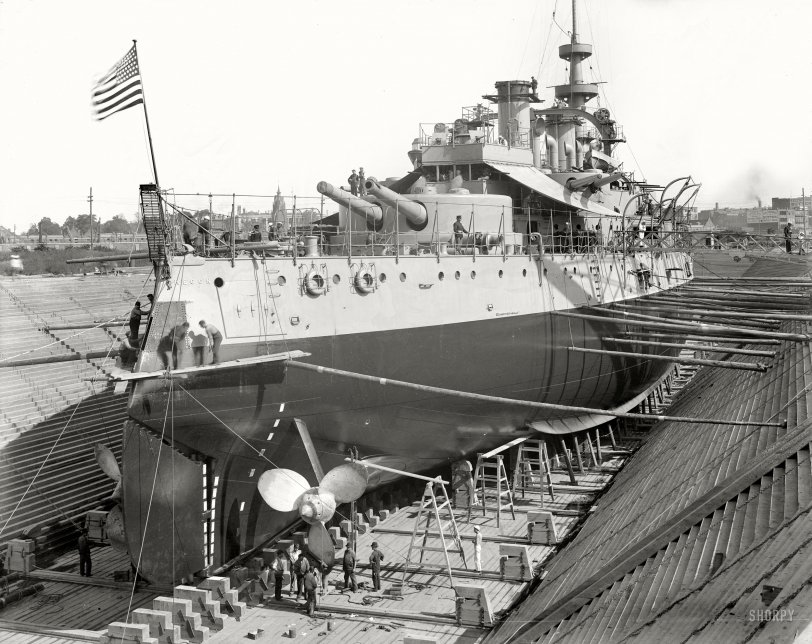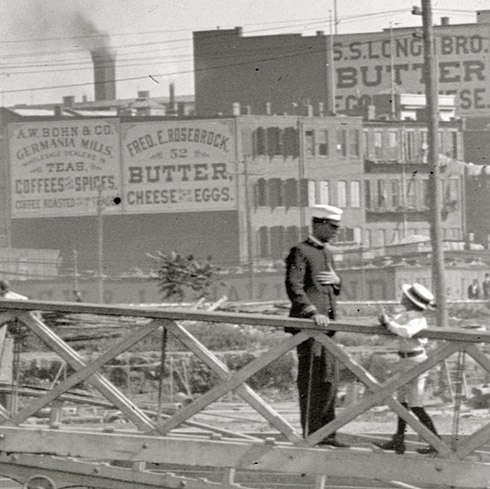


Framed or unframed, desk size to sofa size, printed by us in Arizona and Alabama since 2007. Explore now.
Shorpy is funded by you. Patreon contributors get an ad-free experience.
Learn more.

- Freeze Frame
- Texas Flyer wanted
- Just a Year Too Soon
- WWII -- Replacing men with women at the railroad crossing.
- Yes, Icing
- You kids drive me nuts!
- NOT An Easy Job
- I wonder
- Just add window boxes
- Icing Platform?
- Indiana Harbor Belt abides
- Freezing haze
- Corrections (for those who care)
- C&NW at Nelson
- Fallen Flags
- A dangerous job made worse
- Water Stop
- Passenger trains have right of way over freights?
- Coal
- Never ceases to amaze me.
- Still chuggin' (in model form)
- Great shot
- Westerly Breeze
- For the men, a trapeze
- Tickled
- Sense of loneliness ...
- 2 cents
- Charm City
- What an Outrage
- Brighton Park
Print Emporium
The Oregon: 1898

September 1898. "U.S.S. Oregon in dry dock, Brooklyn Navy Yard." 8x10 inch dry plate glass negative, Detroit Publishing Company. View full size.
In strictly nautical terminology
does this ship have two "pointy ends"?
Scaffolding Inspector
At the very least, you know those knots on the scaffolding ropes are good, probably some lost technology there.
Canned = Pickled
Canned eggs are pickled eggs, sterilized and sealed in mason jars, preserved for future consumption, just like canned fruits.
The scaffolding is a nightmare.
Those guys are at least 30 feet in the air, and the boards look to be 16 to 24 inches wide. You had better pay attention to where you are, and not stand back to look at your handy work. You could only make one mistake on that baby, and it would be your last.
SP250
A feature of ships from this era--indeed, of ships up through at least WW II naval designs--are the inordinate number of stanchions on all the weather decks. These stanchions were used to rig canvas as sun blocks (in port, or dry dock) for sailors forced to work on deck and as an effort to keep below-deck spaces cool(er).
An example of of this rigged canvas is seen in this photo, forward of the 13" turret and aft of the 8" turrets on both the port and starboard sides. It appears the starboard side canvas is shading the quarterdeck area; I think the Officer of the Watch/Deck (looks like a Lt.) is the one on the gangway talking to the youngster.
These stanchions (along with the canvas) were struck and stowed when the ship got underway; obviously, the turrets needed full, unhindered arcs. Stanchions can even be seen aft of the 13" turret in this photo over the two hatches leading to ladders going below decks.
Though necessary, these stanchions often gave these pre-WW II ships an ungainly, cluttered appearance, unlike surface ships of today with their clean lines built to reduce radar return signals.
Railings are for Wimps
The scaffolding I used when I inspected ships in drydock in the 1980's always had a safety railing to prevent you from taking a sudden, almost certainly fatal dive to the concrete floor of the drydock. The scaffolding around Oregon's stern has nothing to hold onto -- terrifying! Men were much braver then.
Some things don't change however -- the light colored objects arranged in neat vertical lines along the leading edge of the rudder and the hull alongside the propeller are almost certainly zincs. These were bolted to the hull, prominently stamped "Do Not Paint," and were used to absorb the galvanic currents created by the bronze of the propeller reacting against the steel of the hull like a giant battery. The idea was for the "sacrificial" zincs, not the hull, to corrode; they were replaced at every drydocking.
I laid out the rows of zincs for the last US battleships during their renovation in 1984. For some reason the World War II plans for zincs couldn't be found in the archives.
"Permission to come aboard, Sir?"
"I'll even trade you this lucky rabbit's foot for a look inside!"
"Yes, yes, that's a fine specimen indeed, but run along now, like a good lad."
At first glance
I thought it was in for oar replacement.
As relayed by semaphore from the US Ethel Merman
"Hello sailor, ever done time aboard a medium-speed twin screw?"
Off to the Side
Of all the activity in this shot, I'd like to hear this conversation.

Dirty Dealer in Canned Eggs
From the NYC health department weekly bulletin of May 7, 1913:
"Nearly 24,000 specimens of milk, as offered for sale in the City, were examined by our inspectors, and of this number only 63 specimens were found to be above the maximum temperature permitted by the Department's regulations. In addition to this 579 samples of milk were taken and upon chemical analysis 99 of these were found to be below the standard.
WHO IS THE PERSISTENT OFFENDER?
On December 18, 1911, F. E. Rosebrock and Company, a corporation dealing in bakery supplies at 325 Greenwich Street, Borough of Manhattan, of which Fred E. Rosebrock was president and a director, was fined $500 for violation of Section 42 of the Sanitary Code, for offering for sale decomposed canned eggs.
On November 18, 1912, the same firm was fined $250 for violation of Section 66a of the Sanitary Code, for using flavoring extracts containing methyl alcohol. About this time the old corporation of F. E. Rosebrock and Company discontinued business at 325 Greenwich Street, and a new corporation, incorporated under the laws of New Jersey, was formed under the name of the Fred. E. Rosebrock Company. Fred E. Rosebrock was president and a director of this company which conducted a business in bakers' supplies at 360 Washington Street. On November 17, 1913, this firm was fined $500 for violation of Section 42 for offering for sale putrid and decomposed eggs.
In August of this year ...a new corporation, known as the Rosebrock Butter and Egg Company, Inc., was formed, incorporated under the laws of New York. Within the past few days criminal prosecution has been commenced by the Department of Health against this firm for an alleged violation of Section 48a. relating to the breaking-out of eggs and the keeping of canned eggs without a permit. Who is the persistent offender?"
Now, what's a canned egg?
Obsolete
The USS Oregon class battleships were already approaching obsolescence when conceived (1888). With their low freeboard, armored turrets, and few quick-firing guns, these ships were already out-classed by the British. The Royal Navy had built battleships comparable to the Oregons back in 1870.
The US Navy should have built ships like these in the decade following the Civil War. We were on the right track with our double-turreted monitors, but the Navy’s budget was reduced to zero in 1866. All that was needed was to add an armored casemate holding some medium caliber weapons to the space between the turrets of our biggest monitors, and the US Navy would have been setting the standards for battleship design instead of the UK.
S.S. Ikea
Today this dry dock (technically a graving dock) is a parking lot for an Ikea superstore. From battleships to "some assembly required" is just 110 years.
Remembering the Maine
When the Maine blew-up on Feb.15,1898, the Oregon's long and perilous voyage from San Francisco through the Strait of Magellan was a deciding factor in gaining the support to build the Panama Canal.
Balancing Act
During my years in the Navy I was aboard two ships that went into dry dock and invariably, once the water was pumped out and the timbers were wedged in place, for the first couple of days we all walked carefully and s-l-o-w-l-y on deck so we wouldn't, uh, you know, tip anything over.
Great pic!
Amazing how much advancement in warships took place in only 35 years from the ironclads of the Civil War.
The workers scaffolding around this boat and especially lower down the side of the boat looks risky.
"McKinley's Bulldog"
An apt nickname for this battleship, gained through her making a determined trip from San Francisco to Florida in 1898 with the outbreak of the Spanish-American War, via the Straits of Magellan where she endured a rather rough passage (which reinforced calls to build the Panama Canal.)
"Oregon" helped finish off Admiral Cervera's fleet off Cuba in July, 1898, and then re-entered dry dock (shown above). She left there in October of that year, only to repeat the passage through the Straits of Magellan, to join Dewey's fleet in the Philippines. "Oregon" was decommissioned in 1919.
Awesome!
This is without a doubt one of the most awesome pictures I have ever seen - thanks, Shorpy!
Ramming Speed!
Great picture. It appears the boys down below have got it set up for ramming speed. Where does the drummer sit?
Muesum ship, for a time
After WWI, she was a museum ship until the outbreak of WWII, where the military needed the metal. Her hull became a barge at Guam during the war before being lost at sea (temporarily, and not euphemistically) during a storm for three day; when eventually refound, she finished as a floating storage barge. Most of the ship ended scrapped in the 1950s, but the masts and funnels (all visible here) have survived to this day, with the mast as the centerpiece of a park.
Once we're done, Admiral,
She'll have that new battleship smell.
























On Shorpy:
Today’s Top 5